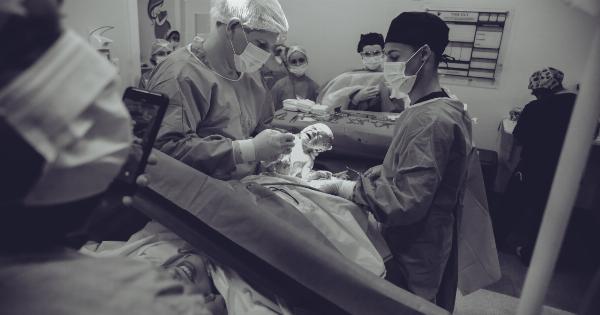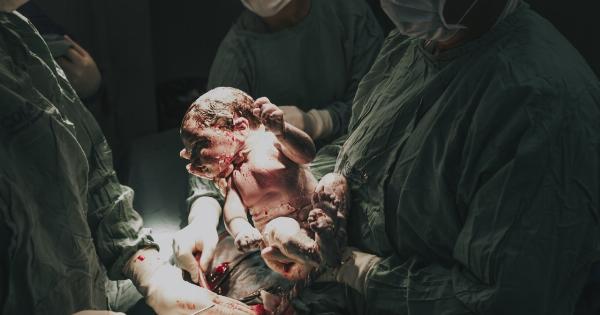Giving birth is a natural and transformative experience for women. Throughout history, women have generally relied on their bodies’ natural ability to bring new life into the world.
However, in recent years, there has been a significant rise in the rates of Caesarean sections (C-sections), which can have several implications, including difficulties in natural childbirth.
The Increase in Caesarean Rates
The World Health Organization (WHO) recommends that the C-section rate should be around 10-15% worldwide. However, many countries are experiencing rates far above these recommendations.
There are several factors contributing to this increase, including medical advancements and the preferences of both doctors and mothers.
Advancements in medical technology have made C-sections a safer option and have helped save countless lives in emergency situations.
However, it is crucial to recognize that C-sections are major abdominal surgeries and should only be performed when medically necessary.
Another contributing factor is the increasing trend of mothers opting for elective C-sections. Some women choose this option due to fear of labor pain or concerns about vaginal childbirth-related complications.
Additionally, convenience plays a role, as mothers can schedule the timing of their delivery, making it more convenient for themselves and their families.
Risks and Complications of C-Sections
Although C-sections can be a life-saving intervention, they are not without risks and complications. Some potential complications include:.
Infection:
Due to the invasive nature of the procedure, there is an increased risk of infection both during and after the surgery.
Increased Blood Loss:
C-sections generally involve more blood loss than vaginal births, which can lead to anemia and may even necessitate blood transfusions in severe cases.
Adverse Reactions to Anesthesia:
While anesthesia is usually safe, some individuals may experience allergic reactions or other negative impacts.
Delayed Mother-Infant Bonding:
C-sections result in a delay in mother-infant bonding as mothers often require more time to recover from surgery.
Impaired Respiratory Function in Newborns:
Babies born via C-section may have more difficulty clearing fluid from their lungs, leading to transient respiratory problems.
Future Implications:
Women who undergo a C-section are at an increased risk of needing the same intervention in subsequent pregnancies. Repeat C-sections can further reduce the chances of having a successful vaginal birth in the future.
The Impact on Natural Birth
The rise in C-section rates can have consequences for women planning to have a natural birth. Several factors contribute to the difficulty in achieving a natural birth after a previous C-section:.
Scar Tissue and Uterine Rupture:
The presence of scar tissue from a previous C-section can weaken the uterine wall and increase the risk of uterine rupture during labor.
While rare, uterine rupture is a severe and life-threatening complication that puts both the mother and baby at risk.
Increased Rates of Induction:
Medical professionals may recommend inducing labor in women who have had a previous C-section to minimize the risk of uterine rupture.
This can lead to a more medicalized birth experience and increase the likelihood of interventions such as epidurals or forceps deliveries.
Anxiety and Fear:
Women who have undergone a difficult or traumatic C-section may experience increased anxiety and fear surrounding childbirth. This emotional burden can impact a woman’s ability to have a positive natural birth experience.
Lack of Support and Access to Resources:
In some cases, women who have undergone a C-section may not receive adequate support or information on how to prepare for a natural birth. This lack of resources can make it difficult for mothers to achieve their desired birthing experience.
The Importance of Promoting Natural Birth
Natural childbirth has several benefits for both mothers and infants. Some benefits of natural birth include:.
Shorter Recovery Time:
Compared to C-sections, women who have given birth vaginally tend to experience a quicker and smoother recovery.
Bonding and Breastfeeding:
Mothers who have a natural birth are often able to establish immediate skin-to-skin contact with their newborns, facilitating early bonding and breastfeeding.
Reduced Risk of Respiratory Problems:
Infants born vaginally have a lower risk of respiratory problems compared to those born via C-section.
Bacterial Inoculation:
During a vaginal birth, infants are exposed to beneficial bacteria from the mother’s birth canal, which contributes to a stronger immune system and overall health.
Steps to Promote Natural Birth
Improved Education and Support:
Healthcare providers should prioritize educating women about the benefits and possibilities of natural birth. This includes debunking myths and providing evidence-based information to help dispel fears or uncertainties surrounding vaginal deliveries.
Reducing Unnecessary C-Sections:
Healthcare systems should work towards reducing the rates of unnecessary C-sections, ensuring that the procedure is only performed when medically necessary.
Supporting Vaginal Birth After C-Section (VBAC):
Women who have had a previous C-section should be provided with information and support if they wish to attempt a VBAC for subsequent pregnancies. This includes assessing their individual circumstances and the potential risks involved.
Conclusion
While C-sections can be a life-saving intervention, the rising rates of unnecessary C-sections have significant implications for natural birth.
It is essential to recognize and address the potential difficulties that arise from high rates of Caesareans, including scar tissue, increased rates of induction, anxiety, and lack of support. By promoting education, reducing unnecessary procedures, and supporting women who want to attempt VBAC, we can work towards a healthcare system that prioritizes the well-being and choices of mothers, facilitating safe and positive natural births.






























